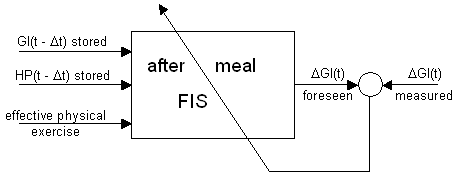

As we previously said, the system is initialized with generic rules based on physicians experience. This rules describe how the glycaemia fluctuates in general cases, which can be considered as reference situations. But each organism is unique and a given situation (premisse of a rule) may engender slightly different reactions depending on diabetics. That is what justify our will to adapt the system to every user's individual specificities, which is achieved by associating the predictive model with an on-line learning system. The latter aims to take advantage of the experience gained during the use of the piece of software by the patient.
When a forecast is asked for, the value of current glycaemia Glt is stored, as well as the hypoglycemic power HPt of the effetive inuslin at this time. The values of intended nature of the meal or exercise are useful only for predictions making but are not memorized because not involved in the learning process: what matters is what really happened, which may be different of what was firstly intended. The learning will occur during the next test of glycaemia after a Δt time length, and before another prediction is done. We could realize the learning by comparing the value of glycaemia forseen by the FIS with the real value, known from now on. This is however not the cleverst choice because the past prediction took into account an a priori estimation of the user, which may not correspond to the reality. Indeed, the user may eventually have had an exercise different from what he intended or a different nature of meal. Even if the FIS gave a value of glycaemia which is different from current value, the prediction is maybe correct in regard with the value that would have be measured if the situation really was the one described. The way of proceeding is the following:

